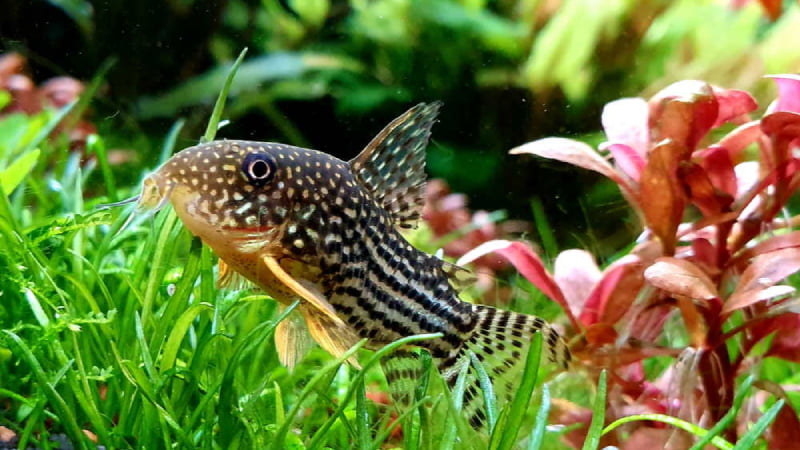A cory catfish is a small, peaceful, personality-filled fish that lives at the bottom of the aquarium. These fish need live plants in order to thrive and feel safe. No matter how new you are to fish care or how seasoned you are – you must know what plants will be the most suitable for your cory catfish.
They prefer to live in groups of at least five, are very shy, and usually like to seek shelter under the protection of plants whenever they feel threatened.
This is why it is important to be aware of the types of plants that are going to be most suitable for your adorable little bottom-dweller. This article will discuss what makes an aquarium plant ideal for your cory catfish, along with the top 8 best plants for cory catfish you should choose to include in the aquarium.
Do Cory Catfish Need Live Plants?
Yes, you do need to provide your cory catfish with many live plants, firstly, to mimic the fish’s natural environment.
Secondly, this particular species of catfish really likes to hide under and within plants, as they are extremely timid and skittish. You must, therefore, ensure that you provide your cory catfish with a lot of live plants.
Of course, live plants also provide aquariums with other benefits. A live plant adds oxygen to an aquarium, one of its biggest benefits.
In addition to oxygenating fish tanks, live plants act as a little bit of filtration. Furthermore, they make aquariums look more natural and attractive.
How To Choose An Aquarium Plant Suitable For Cory Catfish?
When choosing plants for cory catfish, you need to note some of the following points so that the plants will be useful to Cory.
Cary catfish (Corydoras) prefer plants that they can forage off of and plants that provide hiding places. It could be a bush or a large plant with broad leaves. Corydoras aren’t too picky in terms of their preferences, but some live aquatic plants are more suited to the catfish than others.
To minimize damage, avoid plants that cannot tolerate the water conditions of the cory catfish. When selecting plants for the Cory Catfish tank, it is essential to choose plants that can withstand the alkaline, hard water that this fish is used to. You do not need to worry about them uprooting the plants because they are relatively small-sized, and they will rarely interfere with the anchorage of the plants.
Top 8 Best Plants For Cory Catfish
1. Java Fern
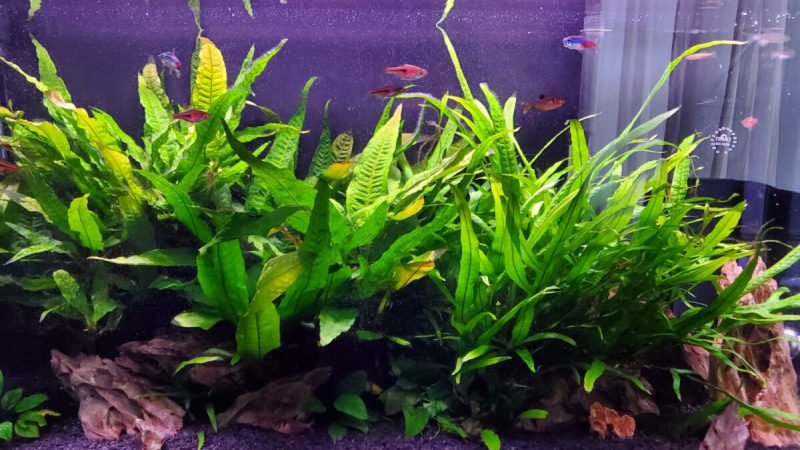
In our opinion, java fern is one of the best options for cory catfish. It is a sturdy aquatic plant that is extremely tolerant to most light conditions. In most pet stores, It is not uncommon to find this plant.
Having a medium growth rate, the Java fern can grow to a height of 12 inches in its leaves. The leaves of this plant are pretty bright green, so they will add a stunning splash of color to any aquarium.
The question is: why is Java fern such a good choice for corydoras? The answer is that their large, broad leaves make them the perfect protection plant. The Java Fern, like the corydoras, is able to thrive under dim light conditions as well.
The Java Fern doesn’t require much care. Ensure that the leaves are trimmed back if they become too large, and then plant them again in your aquarium substrate to promote more growth.
Benefits
- Easy to care for
- It doesn’t require the substrate
- Hardy plants
- It has large leaves that provide shelter
- Adds bright green color to the tank
2. Micro Sword
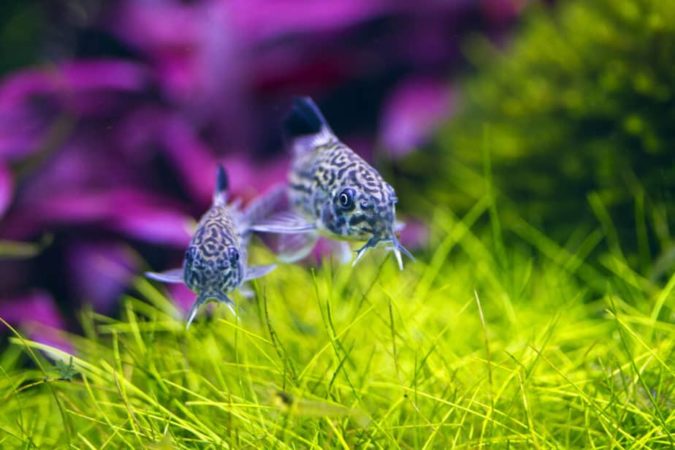
Micro swords, also known as liaeopsis brasiliensis, are a popular choice. You can find it in most pet shops today, even though it may be under a different name, such as Brazilian micro sword grass, carpet grass, micro sword grass, or copragrass.
A Micro sword can grow to an average size of between 2 and 5 inches in a tank under ideal conditions. It appears as a dense, plush grass that Cory catfish can hide in as well as look for food.
The micro sword is a light and airy plant that thrives in water temperatures of 70-82 degrees Fahrenheit. So, just like the Cory, it likes to be in fairly warm water.
The growth rate of a Micro sword is slower in low-tech tanks, whereas, in high-tech tanks coupled with strong lighting, the growth rate can be faster. A grass carpet will form on top of the sand substrate after the grassroots has been established.
Benefits
- It’s quite easy to grow and care for
- Light and airy
- It appears as a dense, plush grass that Cory catfish can hide in
3. Amazon Sword
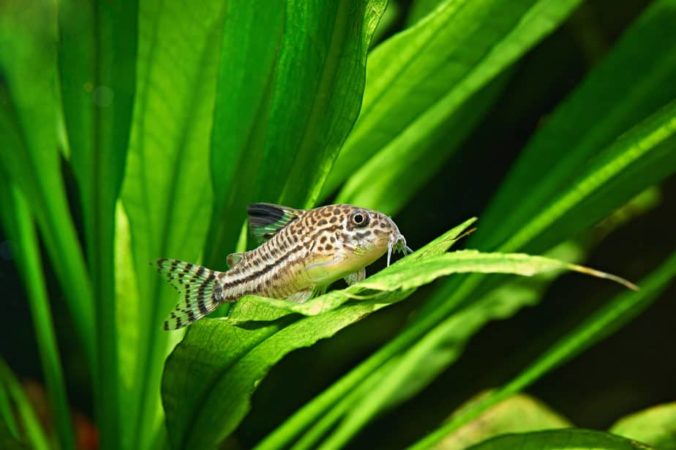
The Amazon sword plant can also be a great option for a catfish aquarium tank. The plants can grow to about 10 inches or even a little more.
It has large, broad leaves that are rounded at the ends. The leaves have a beautiful bright and vivid shade of green. Considering its size, the amazon sword is a great background plant but can also be used to fill in the middle of a tank.
Moreover, the leaves of this plant have a beautiful shape, and they are quite large, which ensures that the cory catfish will have some privacy and protection.
It grows well in a lot of light, and with lots of light, it will grow quickly. Despite that, it can also thrive in dimmer conditions, The plant can also be grown under darker conditions, but its growth rate will be a bit slower. You will need to trim it regularly either way, despite overall maintenance needs being quite minimal for this kind of plant.
As for the water conditions, the amazon sword can be kept in tank conditions and parameters similar to that of cory catfish. When it comes to planting, the amazon sword plant is best done with a fine gravel substrate for planting.
Benefits
- It has large leaves that provide shelter
- Growing quickly with high lighting
- Require minimal maintenance and pruning
- Great for purifying water
- Enhances the tank’s color and texture
4. Anubias Nana
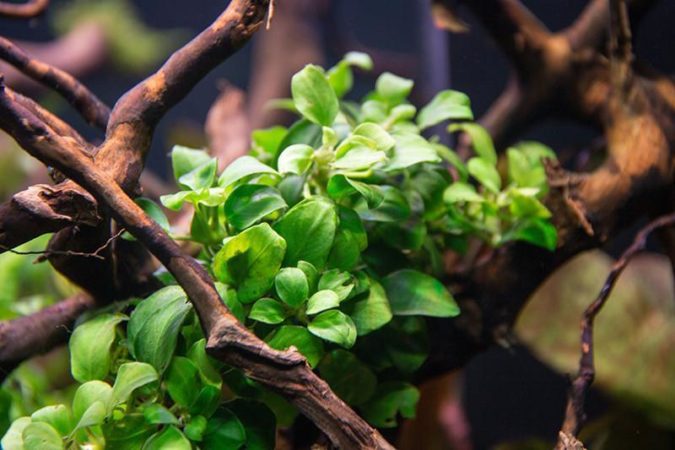
We have a very hardy aquarium plant that can thrive in a wide range of aquarium conditions. It will thrive under very similar conditions and temperatures to that of cory catfish and is and is generally an easy plant to care for and requires little maintenance.
The anubias nana has a relatively slow rate of growth, which means that it requires very minimal trimming. Although it may have a tendency to do better with a lot of light, this plant will also survive just fine under lower lighting conditions.
The anubias nana grows best when planted on a basic gravel substrate, making it an excellent choice for cory catfish tanks.
As this plant will grow to a height of only 5 inches at most, it also tends to grow outwards a bit too, it is a great choice for smaller tanks. Because of this, it is a great foreground or midground plant. Having small and dark green rounded leaves, the anubias nana is a nice addition to any tank, providing a very good color to a tank.
Cory catfish are able to swim under and through the leaves of this plant due to the densely packed leaves, which provide a bit of privacy and security for the fish.
Benefits
- Easy to care for
- Great for small tanks
- Hardy plant
- Low lighting requirement
- Suitable for planting in substrates or for attaching to surfaces
5. Water Sprite
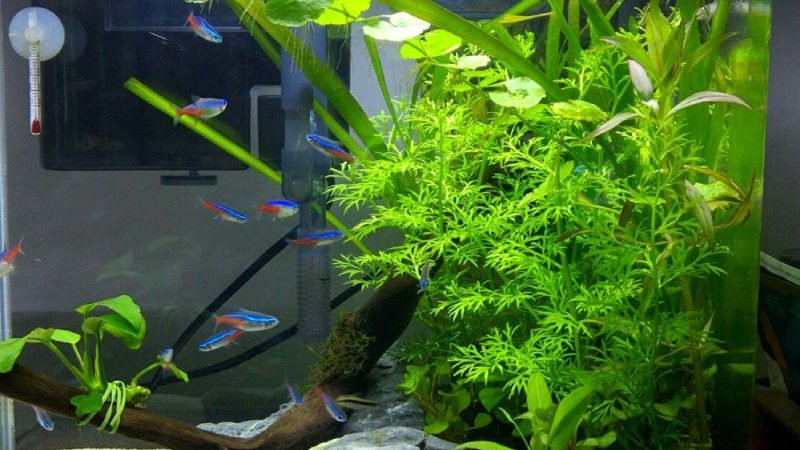
The water sprite is another good plant to put in a cory catfish tank. Using a water sprite for a plant is a cool idea because it can be planted in gravel and soil, or, if you like, it can be used as a floating plant.
Since it is a floating plant, it can provide plenty of coverage from above, although it spreads out quickly and can make for a messy look, it is recommended to plant it in gravel rather than in the soil. It will grow to around 8 to 10 inches in height, making it a good background plant or midground plant.
There are a lot of tiny green leaves on the stems of this plant. Although the leaves of this plant are not very dense for the best cover, Cory can swim around, under, and through the plants easily, and its color also looks quite nice.
This plant can be kept in either high or lower light levels. But it only grows very fast with lots of light. In general, it doesn’t require much maintenance.
Benefits
- This plant propagates easily
- Adaptable to most lighting conditions
- Hardy
- Great for water purity.
- Can be planted in substrate or floated
6. Moss Balls
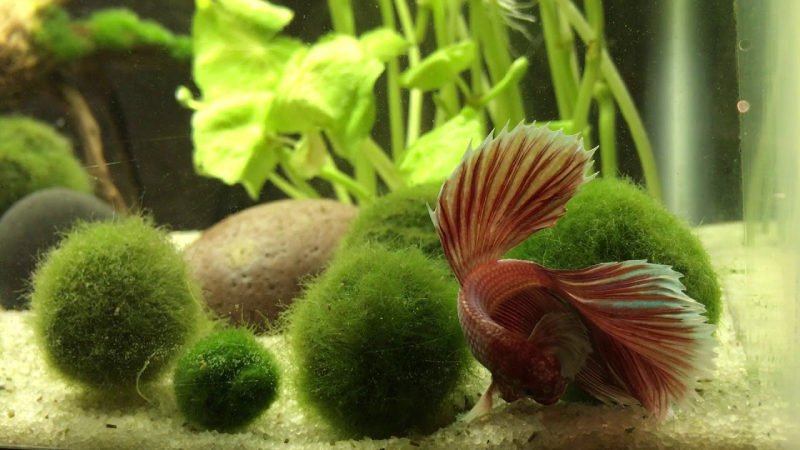
There is something really cool about Moss Balls when it comes to plants for Cory’s aquariums. There is no doubt that these bright green moss balls are very attractive as well as a way of adding a lot of color to any aquarium.
The moss balls are not as many plants on this list that provide corydoras with protection and safety, but they actually serve a special purpose. A moss ball is one of the best naturally growing filters for aquariums. It can take out many of the contaminants found in the aquarium, including nitrates, and improve the water quality by producing oxygen.
In addition, large amounts of plant matter and uneaten food get stuck in their mass, allowing the catfish to pick through them and scavenge for food.
Each moss ball will be only approximately 2 inches in diameter, so they are going to be perfect for placing anywhere in the tank. Moss balls will be able to survive just fine in the same setup of the tank and in the same water conditions as your cory catfish would.
In addition, these moss balls do very well when they are given the right amount of light. On the other hand, they can also be kept in low light conditions and don’t require any special treatment at all.
Benefits
- Easy to care for
- Inexpensive
- The surface area is large enough to support beneficial bacteria
- Pruning and cleaning are almost not needed
- Substrates are not needed
7. Hornwort
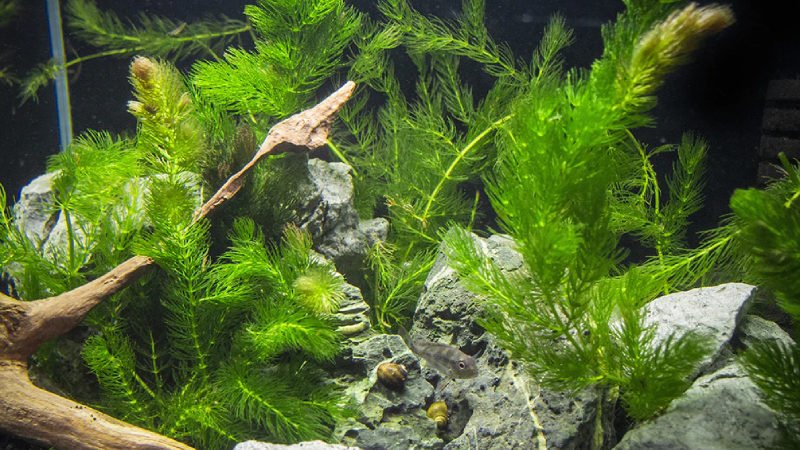
Hornwort definitely makes it one of the best aquarium plants for cory catfish tanks from both size and shape. The appearance of this plant is a lot like the branches of a pine tree. It has lots of leaves arranged in such a way that resembles densely packed needles.
As a result, cory catfish can benefit a lot from this tree. First and foremost, it provides a lot of protection from above with its big, bushy, and needle-like branches.
Secondly, even though the leaves resemble little needles, they are still quite soft, allowing cory catfish to swim under and through them without any difficulties.
Finally, it is likely that the densely packed foliage will also collect other dead plant matter and uneaten food that will then be available for the cory catfish to consume. The bright green color of this plant is a great addition to any aquarium.
This plant can easily reach a height of one foot, and it grows very fast. As for its growth rate, this is one that you will need to trim quite often to prevent it from getting too large, but fortunately, this is one of the easiest aquarium plants to trim.
Also, hornwort grows very quickly in high light levels, but it can also survive in lower light conditions. However, it won’t grow quite as fast. It is best planted in a gravel substrate.
Benefits
- Provides shelter
- Inexpensive
- Hardy
- It is excellent for water quality
- Can be planted in substrate or floated
8. Java Moss
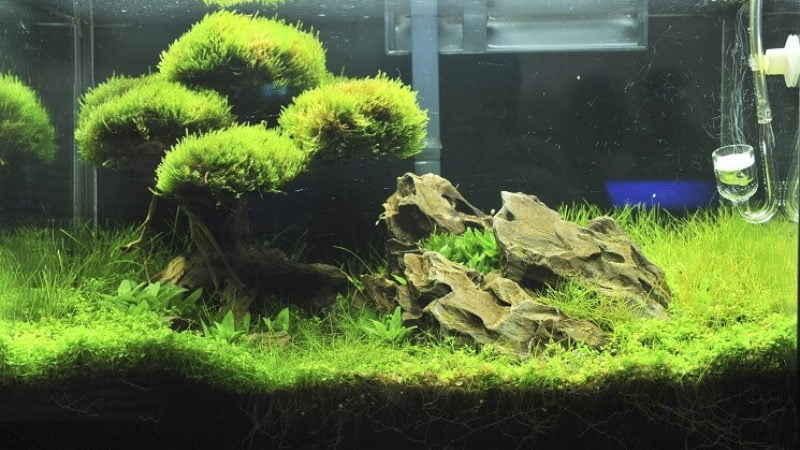
Java moss will also be appreciated by the cory catfish. If you want to use Java moss, you can place it on gravel, or even better, you can tie it to rocks, driftwood, and other decorations so that it stays in place.
Java moss is a dense carpeting plant that grows up rather quickly, filling in the spaces around it with a dense carpet. The plant will not grow much more than 2 inches in height, but it will form a lush, dense greenery carpet that will cover a large area.
The cory catfish will not find any cover in the Java moss, but it does absorb a lot of food that has been uneaten and dead plants that can be eaten by the catfish later. A Java moss plant does not have any special CO2 or light requirements, but if it is given a lot of light, it will grow much faster.
It is an easy task to maintain that plant as it doesn’t require much maintenance, and it can survive in the same water conditions as cory catfish.
Benefits
- Thrives in almost any lighting environment
- Attachable to solid surfaces
- Hardy
- Great for water purity in large quantities
- Collects uneaten food and detritus
Video About Planting The Emerald Green Cory Cats Tank
FAQs
Do cory catfish eat plants?
The Cory catfish is a bottom dweller and is also a bottom feeder. Additionally, it is also a scavenger and an omnivore.
They do sometimes eat plants. However, they tend to scavenge dead or dying plant matter lying on the bottom of a tank rather than eating the live plants in their tank. Generally speaking, you should not be concerned about your live aquarium plants being devoured by your cory catfish.
Do cory catfish clean plants?
Because Cory Cats are relatively small scavengers, they can scavenge among plant stalks, reach into corners, and consume uneaten food from smaller areas that other scavengers might not be able to reach. The plants will naturally be cleaned.
What substrate is best for cory catfish?
Cory catfish prefer sand as a substrate. You can keep cory catfish in almost any type of sand, but soft river sand is the best.
Conclusion
Regarding their preferences when it comes to live plants in their aquarium, cory catfish are not very particular. They can live just fine with the majority of plants as long as they are able to rest and hide under them, hide within their bushes, or simply forage for food from dense carpets of plants.
Selecting the right plants for cory catfish does not require much work or effort. There are plenty of basic aquarium plants that are suitable for cory catfish tanks.

Annette M. Chaney is an experienced marine biologist with over 20 years of experience as an aquarist and fishkeeper. She started her first aquarium at a young age, filling it with frogs and goldfish obtained from the ten-cent pet store.
Annette grew up caring for and breeding African Cichlids, which led to a hobby in high school that doubled as a profitable means. Attending Reed College gave her time to solidify herself as an accomplished aquarium caretaker with an eye for sales. After that, from 2009 – 2013, she studied at Roger Williams University – one of the most prestigious universities for Aquaculture and Aquarium in USA. She is the founder of AquariumCircle since 2010.
